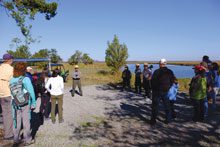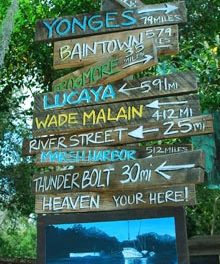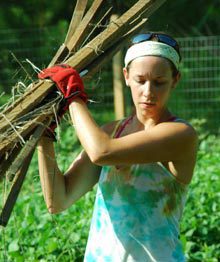 Hunting Island Takes On Ted Turner’s Former
Hunting Island Takes On Ted Turner’s Former Island Retreat
Island Retreat
Interview and Photos by Mark Shaffer
Remember that old line about never looking a gift horse in the mouth? Now, apply it to a gator and bug infested barrier island once owned by a flamboyant billionaire, with no development potential, critically limited access and resources and you’ve got the horse the state park system just handed over to JW Weatherford to whip into shape. Weatherford had barely broken in his desk as the new superintendent of Hunting Island State Park when, after months of top secret negotiations, the state’s prestigious new acquisition landed in his lap, as well.
St. Phillips Island, once the coastal retreat for Ted Turner and family, faces the Atlantic just southwest of Pritchards and Capers Islands. This latest addition to the SC park system is a unique and beautiful conundrum. Remote, rugged, isolated and fragile, Weatherford’s mission as the island’s overseer is to figure out how best to utilize this amazing ecosystem without damaging it.
In mid November park rangers ran the first four public tours of the island. I was fortunate enough to ride along on the final tour and sat down with a very animated park superintendent the night before we departed…
Mark Shaffer: How did the deal work for St. Phillips? It initially went on the market about four years ago for over $20 million, correct?
JW Weatherford: Yes. There actually was an interested buyer when the state was approached about a charitable sale for the conservation and preservation of this property. Once it was determined that if the state buys it, it should go to the parks service, then the Director of PRT and [recently retired] Director of the SC Park Service, Phil Gaines, and a couple of other guys went to visit the property to see what sort of potential the parks could have with it. And so that’s how it started.
charitable sale for the conservation and preservation of this property. Once it was determined that if the state buys it, it should go to the parks service, then the Director of PRT and [recently retired] Director of the SC Park Service, Phil Gaines, and a couple of other guys went to visit the property to see what sort of potential the parks could have with it. And so that’s how it started.
MS: It comes complete with a conservation easement, Turner put in place to preserve it, right?
JW: Yes, the Nature Conservancy has an easement on it. Mr. Turner bought the island in 1979, and by 1983 – I think – he had the nature conservancy involved and got the National Natural Landmark designation. It’s the only National Natural Landmark that the SC State Parks service has now. So, that was big. Regardless of whether Ted Turner ever had anything to do with it, just the fact that it has been designated as a natural national landmark, and in all forty-seven state parks and all the thousands of acres and thousands of miles of trails that the park service has, this is the only [natural national landmark] that we have.
MS: What was going through your head when this became a real possibility?
JW: Well, I found out about it maybe a week before the public found out. The parks director, Phil Gaines at the time – he’s since retired – said it was the best kept secret in PRT. Buying a 4,000-acre private island that was formerly owned by Ted Turner – that’s a pretty big secret! For the newly chosen park manager to have no idea about it … I got this job October 3rd of last year, so I’ve been in this job thirteen and a half months now. Obviously they knew in October that they were pushing forward and trying to buy this island. And so they knew when I was hired, and that was obviously part of the decision making process. They wanted to make sure that I coul d not only handle Hunting Island, the number one most visited park in the state on a fairly regular basis with over a million visitors a year; they wanted to make sure that it was somebody who would be able to juggle a couple of big heavy balls at the same time. And I knew nothing about it, until about a week before it went public, before it started appearing in newspapers.
d not only handle Hunting Island, the number one most visited park in the state on a fairly regular basis with over a million visitors a year; they wanted to make sure that it was somebody who would be able to juggle a couple of big heavy balls at the same time. And I knew nothing about it, until about a week before it went public, before it started appearing in newspapers.
MS: They’ve said they played it close to the vest.
JW: Very. And I think probably because Ted Turner was involved, as well. So yeah, I was surprised that something that big happened without rumors even getting around, and it was really exciting for me. There are a number of plaques [in the visitors’ center] with pictures of all the park managers that have worked here in the past. My degree is in history, and so that legacy of being a park manager is really cool. This park was opened in 1938 by the Civilian Conservation Corps, which was part of the New Deal under FDR. They built the swing bridge so that they could build a park for the public on Hunting Island. And so I’m a part of that legacy as park manager. But I’m sixth or seventh in line as park manager at Hunting Island, whereas I’m the first park manager and I’ll always be the first park manager for this new property. It’s really cool – I’ve got three boys, a 4-year old, a 2-year old, and a 9-month old, that live here on the island, and so that’s really cool just for them growing up and being able to say, you know, my dad was the park manager out there, and my kids can tell their grandkids “Daddy used to be a park manager at Hunting Island, and he was the first park manager for St. Phillips.”
MS: What do we know about the history of St. Phillips?
JW: The most significant historical gem is probably Fort Beauregard that was out on this point (goes to map on wall). So you’ve got Hunting Island, Fripp, Pritchards, Capers Island, and St. Phillips right here. Across the creek, on Bay Point, there was some type of Confederate fort. When the Yankees took that little fort all the Confederates had to retreat across the creek and into St. Phillips, and then back across to St. Helena.
But if you think a lot further past that, about the natural aspect, one thing you notice immediately – especially as a park ranger on Hunting Island – are the differences like the size and diversity of trees at St. Phillips. It’s a more diverse habitat of trees, a lot of hard woods. It’s not just the diversity; it’s the SIZE of the trees. And Hunting Island has some big trees in the interior, but St. Phillips has the largest magnolia trees I have ever seen in this proximity to the ocean. Magnolia trees don’t get this big, this close to the ocean. What those trees tell us historically is that St. Phillips was not always a barrier island. And the reason it tells us that is that barrier islands get so much more damage and stress on trees because they get direct impacts from storms, they get direct salt spray from the ocean, there’s always salt in the air. And so trees on barrier islands are somewhat stunted. Not that they won’t grow 60 feet, 50 feet tall, but the girth. It takes them much, much, much longer to grow large. If you think about St. Phillips’ landmass, it’s got to be about the same age [as the other barrier islands], and so we think historically St. Phillips was a sea island, protected by a barrier island. It would have had part of Pritchards or Capers in front of it to take the brunt of storms. We know all these barrier islands, these sea islands, ebb and flow, especially between the Port Royal Sound and the St. Helena Sound. That’s a big, big water environment. St. Phillips has characteristics of barrier islands, with salt marsh, and maritime forests, and ocean. But it is very unique, because it’s in the middle of that process of turning into a barrier island.
Because of that, there are a lot of different ecosystems inside the island that Hunting Island doesn’t have. There’s more fresh water inside St. Phillip’s. And if you look at an aerial view of St. Phillips you can see these lines that almost look like a cat paw dragging across the sand. It’s ancient sand dunes where trees had grown. And in between those sand dunes, you have sloughs that collect a lot of rainwater. Hunting Island is 5,000 acres, and St. Phillip’s is 4,680 acres, but there’s only 1,070 acres of upland  at St. Phillips. So 3,500 of the acres at St. Phillips at high tide is either marsh or under water. It’s a very tidally influenced island. There’s more diversity in the wildlife, there’s more alligators because there’s more fresh water; we have fox squirrels on St. Phillips. There are no fox squirrels on Hunting. They were probably introduced by the Turners and survived very well. You see more fox squirrels on St. Phillips than you see common grey squirrels.
at St. Phillips. So 3,500 of the acres at St. Phillips at high tide is either marsh or under water. It’s a very tidally influenced island. There’s more diversity in the wildlife, there’s more alligators because there’s more fresh water; we have fox squirrels on St. Phillips. There are no fox squirrels on Hunting. They were probably introduced by the Turners and survived very well. You see more fox squirrels on St. Phillips than you see common grey squirrels.
MS: This unique ecosystem gives it an immediate appeal to the parks system. How’s the long term plan shaping up?
JW: Yeah. You don’t want to get a property like this – as cool as it is, and as unique as it is – you don’t want to open it to the public and then react to issues. You want to be proactive before the public even gets there. Which is why we’re just now letting the public get out there. Two main goals of the park service are to provide excellent quality customer service; we are a service-based hospitality agency, which is unique to a lot of park services. And, then also, which is a little more routine for parks services, to be a responsible steward of the state’s resources. You’ve got to have a plan.
MS: There’s not a lot of room and almost no infrastructure.
JW: It is off the grid. So getting there is tough. And we have to think of a responsible way to get people there, you know, with litigation and insurance. There’s no landing zone for a helicopter on the island, and so there are some major issues that you really have to think through. What if you have a [medical emergency] to deal with? You have to have enough staff to let the public tour continue, while also taking care of the situation.
MS: Yeah, that’s a challenge.
JW: Yeah, it is! We don’t want the public to think about that. When they get out there, we don’t want something that we do to make them think, “What happens if I have a heart attack out here on the beach? Are they going to be able to take care of me? Have they thought about that?” That’s part of our long-term plan, but it’s so much easier normally. Because normally you just dial 9-1-1, and tell them where you are. We provide quality customer service, and we’re not making money unless the public is there. We want people on the island, but it’s not being a responsible steward to take people there, without being able to have a game plan for the safety issues.
MS: You’ve got conservancy issues, you’ve got limited resources; you can only expand so much for accommodations, and the list goes on.
JW: Right. For instance the Nature Conservancy allows up to 10 dwellings, or 10 cabins. I’m not sure we’ve got enough upland to percolate a drain field for septic for 10 cabins.
MS: Are you looking at a plan similar to Cumberland National Seashore with a limited amount of visitors per day?
JW: Well, maybe so. In 2019 we want to be able to develop a routine public tour to St. Phillip’s. And it could be several different things and none of them have been decided upon, because really and truly last weekend and this weekend is our baseline to figure out if we have really thought about everything. How much is it really going to cost per person to go out there? What does our price point really need to be? And we’re kind of breaking even this weekend, maybe, if we’re lucky.
MS: What’s been the response to these tours?
JW: The sold out in less than three days, and we did very little marketing. Like, the Park Service website, Park Service Facebook, Park Service Instagram. And then I got our friends group to do an email blast to their 2,000 Friends of Hunting Island members. Garden and Gun picked up the story, and we didn’t even realize that. And it booked all four days, 64 spaces, in less than three days. So we know there are a lot of people who will want to go out there. We just have to figure out what the tours are going to look like exactly. We have to figure out if we’re going to continue to contract out a water taxi service.
And I would think that the overnight accommodations are going to be a further long-term plan. The immediate long-term plan – the 2019 plan – is to get a routine of public tours. Whether it’s one weekend a month, two weekends a month, maybe two weekends a month during the fall, that’s what we’re going to establish. And at the end of 2019, we hope to have the Turner house, the Turner Lodge, available for overnight accommodation. And that will be similar to a weeklong beach rental house. The difference being when the house is rented we will not be doing public tours. When you rent the Turner house, six bedrooms and five baths, you get the island. You’re renting a private island.
And with that, I would imagine, because I’m guessing there’s a whole lot of people who would love to do that, without even looking at the price, you’ll have to look at how many times you can do that throughout the year, without getting away from the public tours.
MS: Sounds like a lot of juggling.
JW: A lot, yeah, exactly.
MS: These [initial] tours are finished. And you going to do some more during the winter or is this a warm weather type of thing?
JW: Probably spring, we’ll start back. We’ve designed this tour and we’re doing it with Hunting Island staff, and with some regional staff. And we can’t sustain that because, well, most of us would say we’re already somewhat understaffed. The staffing we have at Hunting Island is the staffing we have for Hunting Island. We have two employees that work for me out at St. Phillips. They’re maintenance guys, they keep the place running. They worked for Ted Turner, so they know the island systems: the solar, the water, the sewer, and the generators. And the reason there’s going to be a delay until the spring, is because we’re going to train several teams of park rangers from across the state. A+ rangers who we feel confident can do tours like this with their eyes closed, because that’s what we do, we want to provide excellent quality customer service to our visitors while being responsible stewards. This is what we do.
To be continued…
In the December 19 edition of Lowcountry Weekly and lowcountryweekly.com ride along for the final public tour of St. Phillips Island for 2018.







